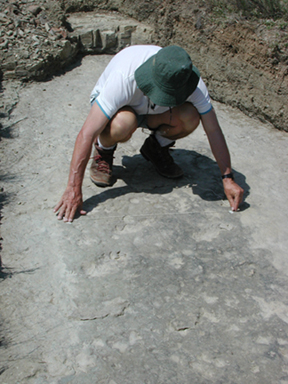 The great debate
continues over the Great Dying — the largest of all mass extinctions, which
occurred 250 million years ago, when up to 90 percent of marine organisms and
70 percent of terrestrial organisms died off. The latest round of research casts
doubt on an extraterrestrial impact as the cause of the extinction event.
The great debate
continues over the Great Dying — the largest of all mass extinctions, which
occurred 250 million years ago, when up to 90 percent of marine organisms and
70 percent of terrestrial organisms died off. The latest round of research casts
doubt on an extraterrestrial impact as the cause of the extinction event. Roger Smith measures ancient reptile footprints from the uppermost Permian, in the Karoo Basin in Bethulie, South Africa. He is part of a research team led by Peter Ward that says the mass extinction at the Permian-Triassic boundary 250 million years ago was gradual and thus more complicated than a catastrophic impact event. Photo by Peter Ward.
Over the years, scientists have developed many ideas about what set off the large extinction event at the boundary between the Permian and Triassic (P/T), including large-scale volcanism in Siberia, development of oxygen-depleted oceans, changes in sea level or a combination of these. Each of these ideas relies on climate change to drive the extinction with carbon dioxide playing a principal role by creating a greenhouse effect, thereby increasing temperature and decreasing available oxygen. Other scientists have suggested that the culprit was the impact of an asteroid or comet, as proposed for the extinction event 65 million years ago at the Cretaceous-Tertiary boundary (K/T), when the dinosaurs died off.
Luann Becker of the University of California, Santa Barbara, and colleagues have built a case for the P/T impact over the past several years. Citing carbon “buckyballs,” or fullerenes, with extraterrestrial helium and argon, meteorite fragments and other evidence, they say that an approximately 9-kilometer-wide extraterrestrial object hit Earth and triggered the extinction. In Science last June, she and colleagues pointed specifically toward an impact on the Bedout High, located on the northwestern continental margin of Australia (see Geotimes, July 2004). They do not entirely blame the P/T extinction on an impact, but note that volcanism alone could not generate enough carbon dioxide in the atmosphere to lead to the rapid die-off at that boundary.
New research, however, questions Becker’s impact evidence. In work originally presented at the fall meeting of the American Geophysical Union and now submitted to Earth and Planetary Science Letters, Kenneth Farley of Caltech in Pasadena, Calif., and colleagues report an absence of extraterrestrial helium in marine-deposited P/T sediments from Opal Creek, Canada. In addition, the study questions Becker’s report of extraterrestrial helium from rocks in Antarctica and suggests the material may have been contaminated. The new research complements work Farley and others presented in the December 2004 Geology, which found no impact evidence in marine P/T rocks from Austria.
“It is hard to rule out an event like an impact; my work simply fails to confirm [Becker et al.’s] observations with respect to helium at the boundary. Others have contested other aspects of her work,” Farley says. “Taken as a whole, there is a great deal of doubt about an impact at that boundary.”
Further fuel for the debate comes from Peter Ward of the University of Washington and a team of researchers from the United States and South Africa, who examined vertebrate fossils and terrestrial sediments from the Karoo Basin in South Africa at the P/T boundary. They also used paleomagnetism and carbon isotope data to correlate sediments within the basin and equivalent-aged rocks from China, as published in the Feb. 4 Science.
“We see a gradual extinction leading to a sharp increase at the P/T boundary. This is followed by a continued extinction after the boundary,” Ward says. The team writes that the pattern “is consistent with a long-term deterioration of the terrestrial ecosystem,” produced by an increase in temperature and drop in oxygen levels. “We didn’t find any evidence for a catastrophic event, which doesn’t rule out an impact, but it does show that the P/T extinction was far more complicated than a K/T-type extinction event,” Ward says.
None of the new research has delivered a fatal blow to either side, says Arnie Miller, a paleontologist at the University of Cincinnati. “I am skeptical of the current evidence for a P/T impact, but a gradual extinction in one region does not necessarily prove that there wasn’t an impact,” Miller says. “Ward’s work reminds us that individual regions may have their own peculiarities that overprint any global signal.”

